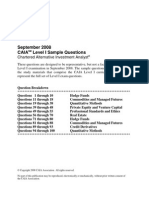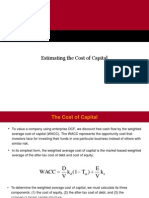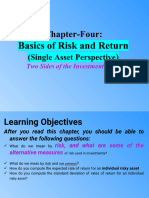Assignment 2
Assignment 2
Uploaded by
siddev12344321Copyright:
Available Formats
Assignment 2
Assignment 2
Uploaded by
siddev12344321Copyright
Available Formats
Share this document
Did you find this document useful?
Is this content inappropriate?
Copyright:
Available Formats
Assignment 2
Assignment 2
Uploaded by
siddev12344321Copyright:
Available Formats
Assignment 2
The following table of compound annual returns by decade applies to problem 1 to 2
Q1: input the data from the table into a spread sheet. Compute the serial correlation in
decade returns for each asset class and for inflation. Also find the correlation between
the returns of various asset classes. What do the data indicate?
Q2: Convert the asset returns by decade presented in the table into real rates. Repeat
problem 1 for the real rates of return.
Visit professor Kenneth French’s data library website:
http://mba.tuck.darmouth.edu/pages/faculty/ken.french/data_library.html and
download the monthly return of “6 portfolios formed on size and book to market (2 x
3).” choose the value weighted series for the period from january 1930 december
2018. split the sample in half and compute the average, SD, skew, and kurtosis for
each of the six portfolios for the two halves. Do the six split halves statistics suggest
to you that return come from the same distribution over the entire period?
Q3: During a period of severe inflation, a bond offered a nominal HPR of 80% per
year. The inflation rate was 70% per year.
a. What was the real HPR on the bond over the year?
b. Compare this real HPR to the approximation rreal ≈ rnom - I.
Q4: Suppose that the inflation rate is expected to be 3% in the near future. Using the
historical data provided in this chapter, what would be your prediction for:
a. The T-bill rate?
b. The expected rate of return on the Big/Value portfolio?
c. The risk premium on the stock market?
Q5: Consider a portfolio that offers an expected return-standard deviation of 18%. T-
Bills offer a risky-free 7% rate of return. What is the maximum level of risk aversion
for which the risky portfolio is still preferred to T-Bill.
Assignment 2
Q6: Suppose that your risky portfolio includes the following investments in the given
propositions:
Stock A 25%
Stock B 32%
Stock C 43%
What are the investments propositions of your client’s overall portfolio, including the
position in T-bills?
Q7: Your Client’s degree of risk aversion is A=3.5.
a. What proposition, y, of the total investment should be invested in your funds?
b. What are the expected value and standard deviation of the rate of return on your
client’s optimized portfolio?
Q8. Why do we call alpha a NONMARKET return premium? Why are the high alpha
stocks desirable investments for active portfolio managers? With all other parameters
held fixed, what would happened to a portfolio’s Sharpe ratio as the alpha of its
component securities increased?
Q.9 A portfolio management organization analyzes 60 stock and constructs a mean -
variance efficient portfolio using only these 60 securities.
A. How many estimates of expected return, variances, and covariance are needed to
optimize this portfolio?
B. if one could safely assume that stock market returns closely resemble a single
index structure, how many estimates would be needed?
You might also like
- Case 2a - Flirting With Risk - SolutionDocument5 pagesCase 2a - Flirting With Risk - SolutionMahesh Satapathy67% (3)
- Asset Allocation CasequestionsDocument3 pagesAsset Allocation Casequestionsobliv11No ratings yet
- Diamond, "What Makes Countries Rich or Poor - Week5Document3 pagesDiamond, "What Makes Countries Rich or Poor - Week5fathi ELbermbaliNo ratings yet
- FIN501 - Financial Management Mid Term Assignment - Zin Thet Nyo LwinDocument16 pagesFIN501 - Financial Management Mid Term Assignment - Zin Thet Nyo LwinZin Thet InwonderlandNo ratings yet
- INA W5Formative TSDocument5 pagesINA W5Formative TSNayden GeorgievNo ratings yet
- September 2008 Caia Level I Sample Questions: Chartered Alternative Investment AnalystDocument27 pagesSeptember 2008 Caia Level I Sample Questions: Chartered Alternative Investment AnalystRavi Gupta100% (1)
- #1 - Midterm Self Evaluation SolutionsDocument6 pages#1 - Midterm Self Evaluation SolutionsDionizioNo ratings yet
- Module 3 - FILMORE ENTERPRISES - QuestionsDocument4 pagesModule 3 - FILMORE ENTERPRISES - Questionsseth litchfieldNo ratings yet
- Valuation Method ExamsDocument75 pagesValuation Method ExamsRhejean Lozano100% (2)
- Sample Final Exam Larkin AnswersDocument18 pagesSample Final Exam Larkin AnswersLovejot SinghNo ratings yet
- Gainesboro Machine Tools Corporation: Other Cases in Which Dividend Policy Is An Important IssueDocument22 pagesGainesboro Machine Tools Corporation: Other Cases in Which Dividend Policy Is An Important IssueUshnaNo ratings yet
- Act7 2Document4 pagesAct7 2Helen B. EvansNo ratings yet
- Problem 4Document7 pagesProblem 4billyNo ratings yet
- Homework 2Document5 pagesHomework 2siddev12344321No ratings yet
- BD5 SM12Document10 pagesBD5 SM12didiajaNo ratings yet
- Homework 1Document3 pagesHomework 1wrt.ojtNo ratings yet
- Lecture 19Document103 pagesLecture 19billyNo ratings yet
- Lcture 3 and 4 Risk and ReturnDocument8 pagesLcture 3 and 4 Risk and ReturnNimra Farooq ArtaniNo ratings yet
- Suppose A Stock Had An Initial Price of 83 Per ShareDocument8 pagesSuppose A Stock Had An Initial Price of 83 Per ShareDoreenNo ratings yet
- Assignment 1, Mgtf402 Investment Analysis (Due October 9, 2017)Document2 pagesAssignment 1, Mgtf402 Investment Analysis (Due October 9, 2017)minghui0% (1)
- Lcture 3 and 4 Risk and ReturnDocument4 pagesLcture 3 and 4 Risk and ReturnSyeda Umaima0% (1)
- Tutorial 4Document3 pagesTutorial 4Huế HoàngNo ratings yet
- Selected BKM Exercises 1 - v2Document19 pagesSelected BKM Exercises 1 - v2Mattia CampigottoNo ratings yet
- Problem Set 2Document4 pagesProblem Set 2Omar SrourNo ratings yet
- Chapter 8 QuestionsDocument7 pagesChapter 8 QuestionsVinay YevatkarNo ratings yet
- Case Study of Equitty Analysis - MbaDocument2 pagesCase Study of Equitty Analysis - MbaAli HyderNo ratings yet
- Mock Exam - Section ADocument4 pagesMock Exam - Section AHAHAHANo ratings yet
- Utility Theory and Portfolio ManagementDocument3 pagesUtility Theory and Portfolio ManagementMd Roni HasanNo ratings yet
- Estimating The Cost of CapitalDocument32 pagesEstimating The Cost of CapitalRRafeh119No ratings yet
- Investemnts Answers To Problem Set 6Document6 pagesInvestemnts Answers To Problem Set 6chu chenNo ratings yet
- IM Problem Set 4Document3 pagesIM Problem Set 4Moe EltayebNo ratings yet
- FIN300 Homework 3Document4 pagesFIN300 Homework 3JohnNo ratings yet
- Case Study - WACC in Practice and Change in Capital Structure - 231024Document4 pagesCase Study - WACC in Practice and Change in Capital Structure - 231024lolojNo ratings yet
- Strathclyde University Finance & Financial Management Group-Based AssignmentDocument4 pagesStrathclyde University Finance & Financial Management Group-Based AssignmentJuan SanguinetiNo ratings yet
- Sample Exam PM Questions PDFDocument11 pagesSample Exam PM Questions PDFBirat SharmaNo ratings yet
- FN2190 Ota Final Exam PaperDocument7 pagesFN2190 Ota Final Exam PaperNoor NoorNo ratings yet
- Investment ManagementDocument15 pagesInvestment ManagementsamgoshNo ratings yet
- Workshop 5 Topics 11 and 12Document2 pagesWorkshop 5 Topics 11 and 12Dweep KapadiaNo ratings yet
- Chapter 6 Risk and Return, and The Capital Asset Pricing Model ANSWERS TO END-OF-CHAPTER QUESTIONSDocument10 pagesChapter 6 Risk and Return, and The Capital Asset Pricing Model ANSWERS TO END-OF-CHAPTER QUESTIONSSolutionz Manual50% (2)
- FIE400E 2018 SpringDocument9 pagesFIE400E 2018 SpringSander Von Porat BaugeNo ratings yet
- Problem Set 1Document3 pagesProblem Set 1ikramraya0No ratings yet
- QLDMDTDocument35 pagesQLDMDThang25040107No ratings yet
- Act std4Document3 pagesAct std4Helen B. EvansNo ratings yet
- Tutorial 3-IpmDocument6 pagesTutorial 3-IpmNguyễn Phương ThảoNo ratings yet
- Compared To Investing in A Single Security, Diversification Provides Investors A Way ToDocument8 pagesCompared To Investing in A Single Security, Diversification Provides Investors A Way ToDarlyn ValdezNo ratings yet
- Risk, Return & Capital BudgetingDocument12 pagesRisk, Return & Capital BudgetingIrfan ShakeelNo ratings yet
- Econf412 Finf313 Comp QDocument6 pagesEconf412 Finf313 Comp Qbits.goa2027No ratings yet
- Econf412 Finf313 Mids SDocument11 pagesEconf412 Finf313 Mids SArchita SrivastavaNo ratings yet
- Risk and Return Practice QuestionDocument5 pagesRisk and Return Practice QuestionWajid WajidNo ratings yet
- CH 06Document21 pagesCH 06Junaid JamshaidNo ratings yet
- Discounted Cashflow Valuation Problems and SolutionDocument54 pagesDiscounted Cashflow Valuation Problems and SolutionJang haewonNo ratings yet
- Prob Set 4Document3 pagesProb Set 4ebrahimnejad64No ratings yet
- SOALDocument2 pagesSOALrio hendriadi0% (1)
- Financial Markets Past Exam QuestionsDocument5 pagesFinancial Markets Past Exam QuestionsDaniel MarinhoNo ratings yet
- Q 1Document6 pagesQ 1ricamae saladagaNo ratings yet
- CaseDocument4 pagesCaseRaghuveer ChandraNo ratings yet
- Suraj Lums Edu PKDocument9 pagesSuraj Lums Edu PKalice123h21No ratings yet
- FIN-MAN305 Tutorial 2 - Chapter 2 - Chapter 4Document4 pagesFIN-MAN305 Tutorial 2 - Chapter 2 - Chapter 4max495898No ratings yet
- Risk, Returns and WACC: CAPM and The Capital BudgetingDocument41 pagesRisk, Returns and WACC: CAPM and The Capital Budgetingpeter sumNo ratings yet
- Make Money With Dividends Investing, With Less Risk And Higher ReturnsFrom EverandMake Money With Dividends Investing, With Less Risk And Higher ReturnsNo ratings yet
- Beyond Earnings: Applying the HOLT CFROI and Economic Profit FrameworkFrom EverandBeyond Earnings: Applying the HOLT CFROI and Economic Profit FrameworkNo ratings yet
- CFA 2012 - Exams L1 : How to Pass the CFA Exams After Studying for Two Weeks Without AnxietyFrom EverandCFA 2012 - Exams L1 : How to Pass the CFA Exams After Studying for Two Weeks Without AnxietyRating: 3 out of 5 stars3/5 (2)
- Chapter No. 3 How Securities TradedDocument11 pagesChapter No. 3 How Securities Tradedsiddev12344321100% (1)
- Create Exhibit 1 With Proper Table ImageDocument4 pagesCreate Exhibit 1 With Proper Table Imagesiddev12344321No ratings yet
- Chapter No 2 Investments NotesDocument20 pagesChapter No 2 Investments Notessiddev12344321No ratings yet
- Chapter No 6 Investments NotesDocument14 pagesChapter No 6 Investments Notessiddev12344321No ratings yet
- Portfolio Theory by MikeDocument22 pagesPortfolio Theory by Mikesiddev12344321No ratings yet
- 金融科技PAPERDocument21 pages金融科技PAPERsiddev12344321No ratings yet
- Ch01 GlobalizationDocument4 pagesCh01 Globalizationsiddev12344321No ratings yet
- Ch06 Parity RelationshipsDocument6 pagesCh06 Parity Relationshipssiddev12344321No ratings yet
- Formula - Chapter 07 Futures OptionsDocument2 pagesFormula - Chapter 07 Futures Optionssiddev12344321No ratings yet
- 1 s2.0 S0929119923000962 MainDocument21 pages1 s2.0 S0929119923000962 Mainsiddev12344321No ratings yet
- Joint Arrangements: Problem 6-1: True or FalseDocument18 pagesJoint Arrangements: Problem 6-1: True or FalseVenz LacreNo ratings yet
- Equities and Portfolio ManagementDocument55 pagesEquities and Portfolio ManagementAK Creations100% (1)
- Chapter 4 Capital Budgeting and Basic Investment Appraisal TechniquesDocument34 pagesChapter 4 Capital Budgeting and Basic Investment Appraisal TechniquesarjunNo ratings yet
- Maruti Vs Tata - EXCELDocument15 pagesMaruti Vs Tata - EXCELParth MalikNo ratings yet
- Asian Paints 1Document7 pagesAsian Paints 1akaish26No ratings yet
- The ESG Global Survey 2021Document54 pagesThe ESG Global Survey 2021Ebraim AndradeNo ratings yet
- Task 3Document6 pagesTask 3Hirianov MirabelaNo ratings yet
- IIM QA Special 2: Page 1 of 4Document4 pagesIIM QA Special 2: Page 1 of 4solanki YashNo ratings yet
- Question 11 Mark: FR 1 - Practice Quizcollapse All AnswersDocument5 pagesQuestion 11 Mark: FR 1 - Practice Quizcollapse All Answerschiayi91No ratings yet
- Financial Management Notes SummaryDocument6 pagesFinancial Management Notes SummaryAeris StrongNo ratings yet
- Financial MGT 1 CHAPTER 4 Part IDocument68 pagesFinancial MGT 1 CHAPTER 4 Part IKhalid MuhammadNo ratings yet
- Paccar Truck Leasing I. Title of The CaseDocument8 pagesPaccar Truck Leasing I. Title of The CaseDan GabonNo ratings yet
- Profile SheetDocument11 pagesProfile SheetRamen SarmaNo ratings yet
- DBA 320 Exam DecDocument12 pagesDBA 320 Exam DecMabvuto PhiriNo ratings yet
- BCG Global Asset Management 2020 May 2020 R - tcm9 247209 PDFDocument27 pagesBCG Global Asset Management 2020 May 2020 R - tcm9 247209 PDFLawrence HNo ratings yet
- ISJ013Document84 pagesISJ0132imediaNo ratings yet
- Indian Data Centre Industry To Reach 1700 MW Capacity by 2025 at 40 Cagr Attracting Usd 5 Billion Avendus CapitalDocument1 pageIndian Data Centre Industry To Reach 1700 MW Capacity by 2025 at 40 Cagr Attracting Usd 5 Billion Avendus CapitalAnonymous H8AZMsNo ratings yet
- 2017 Annual Report Final e Sig PDFDocument186 pages2017 Annual Report Final e Sig PDFKristen CollierNo ratings yet
- Corporate FinanceDocument36 pagesCorporate FinanceCHARAK RAYNo ratings yet
- Deratives (F&B)Document4 pagesDeratives (F&B)Nhật Hoàng MinhNo ratings yet
- Pinoy Entrepreneurial Characteristics and Business StudiesDocument5 pagesPinoy Entrepreneurial Characteristics and Business StudiesChristian RiveraNo ratings yet
- Ae 121 QuizDocument3 pagesAe 121 QuizQueenie ValleNo ratings yet
- Stable DividendDocument6 pagesStable Dividendanon-821638100% (2)
- Activists ListDocument4,063 pagesActivists ListssdebNo ratings yet
- FINMAN TestBank1 PDFDocument9 pagesFINMAN TestBank1 PDFSteven consueloNo ratings yet
- 7.1a Principal-Protected Notes: Trading Strategies Involving OptionsDocument14 pages7.1a Principal-Protected Notes: Trading Strategies Involving OptionsAnDy YiMNo ratings yet
- Asset Management - An Anatomy (2nd Ed.)Document80 pagesAsset Management - An Anatomy (2nd Ed.)Henoc Balderas83% (6)



































































































